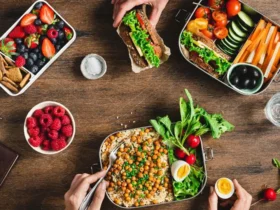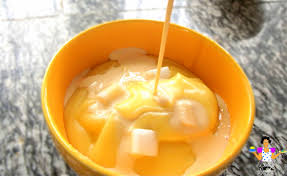Afang Soup: A Delicious Nigerian Vegetable Stew
Traditionally Eaten by the Efik and Ibibio People
Afang soup is a delectable stew enjoyed by the Efik and Ibibio people of Nigeria. This flavorful dish is prepared using Afang leaves and another leafy green vegetable called waterleaf, also known as Malabar spinach.
A Trip to Flavortown
For those who haven’t been to an African market, this Afang soup recipe might be the motivation you need to make the trip. Trust me, this dish is worth the adventure! Do a quick web search for “African grocery stores near me” and get ready to embark on a delicious journey.
For those already familiar with African grocery stores, or those who live on the great continent itself, this recipe should be a breeze.
Let me introduce you to my amazing Afang soup recipe, a leafy vegetable soup traditionally associated with Calabar, Nigeria, but with deep cultural roots in the Ibibio and Efik communities of the country’s riverine areas.
These two tribes, residing in the Akwa-Ibom and Cross River states in Southern Nigeria, prominently feature this soup in their cuisine and celebrations.
To my knowledge, there aren’t any major variations in their preparation methods.
A Bit of Personal History
My mother comes from a state in Nigeria called Akwa-Ibom, and there’s a common stereotype that the women from this region cook the best food in Nigeria.
I may be a tad biased, but as a young woman with a heritage split between Ibibio (a tribe in Akwa-Ibom state) and Esan (a tribe in Edo state), I grew up in Lagos with a wonderfully diverse family. Let me assure you, this stereotype is likely quite true.
My mom, her four sisters, my late grandmother, and just about everyone on my mom’s side who cooked for us always made the most incredible meals. Nothing beats the delicious soups and stews that originated from my mom’s side of the family.
I distinctly remember the disappointment of trying non-Akwa-Ibom pepper soup for the first time. From that moment on, I knew I had been raised with a privileged palate.
Afang Soup: Beyond Nigeria
Afang soup is one of the many delectable dishes from my mom’s side of the family. I’ve since learned that this dish is also prepared by some Cameroonians, as some parts of Cameroon share a border with Akwa-Ibom state.
There are other dishes that Cameroonians and people from Cross River/Akwa-Ibom share, which I’ll discuss in the future.
What is Afang Leaf?
Also known as Eru in Cameroon and Okazi in other areas of Nigeria, Afang leaf is a flavorful green leafy vegetable called Gnetum africanum.
It’s commonly grown in West Africa and used in various soups and stews. Afang is one of the most prevalent leafy vegetables in Nigeria and can also be found abundantly in Cameroon, Gabon, Congo, and Angola.
A Staple Soup
Afang soup, prepared by the Efik and Ibibio people who primarily live in the coastal states of Cross River and Akwa-Ibom (two neighboring states out of the six Southern states that make up the nicknamed “South South” regions of Nigeria), is a stew made with Afang leaves and another common leafy green vegetable called waterleaf.
Afang soup is a true staple in the coastal cities of Southern Nigeria and is a prominent feature in ceremonies and festivals of the Ibibio, Efik, and other residents of the “South South,” including weddings, christenings, and even funerals.
Since Cross River and Akwa-Ibom states are riverine, many stews and soups originating from these regions are prepared with some type of seafood and may include a variety of assorted meats, as showcased in this recipe.
How to Prepare Afang Soup
Our stews and soups can be prepared surf and turf style (like in this recipe), but most Efik or Ibibio stews and soups that are not vegan typically include seafood.
In this Afang soup recipe, I use shelled clams and small shelled apple snails, but you could also use smoked dried fish, periwinkles, fresh or dried shrimp, crabs, oysters, or any other type of seafood you enjoy.
List of Ingredients
- 2 lbs (about 907 grams) Malabar Spinach or Waterleaf (waterleaf can be substituted with lamb’s lettuce, but Malabar spinach is the best alternative)
- 57 grams or 2 ounces dried Afang leaves (may be labeled Okazi/Eru at the African store) – Afang leaves have no known substitute, so if you’ve never been to an African grocery store, you’ll need to visit one to try this Afang soup recipe. Just ask for Okazi or Eru. In a pinch, Afang leaves can also be purchased online, but I highly recommend going to an African store if you can.
- 3 lbs (About 1.4 kg) Goat meat cut into large bite-sized cubes (feel free to omit this and all animal products for a vegan version)
- ½ cup cooked shelled Apple snails
- ½ cup cooked shelled Clams
- ½ cup palm oil
- 2 Red onions
- 2 Scotch bonnet peppers (you can substitute with habanero peppers)
- 4 tbsp Ground smoked dried shrimp (also known as crayfish)
- 3 tsp Chicken Bullion
- 2 tbsp cayenne pepper/ crushed red pepper flakes (optional)
- Salt to taste
Prep the Onions and Peppers
Begin by slicing both the onions and scotch bonnet peppers. Set them aside for later.

Braise the Goat Meat
On medium-low heat in a large stockpot, braise the goat meat (or your preferred protein) with one of the onions, the scotch bonnet peppers, 1 teaspoon of bouillon, and 1 teaspoon of salt. Braise for 30 minutes, or until the meat is tender.
Halfway Through Braising
Halfway through braising the goat meat, add ½ cup of water and stir the meat to prevent burning. Keep the pot covered throughout the braising process. Once the meat is tender and cooked through, set it aside.

Prep the Waterleaf/Malabar Spinach
While the meat braises, wash your Malabar spinach or waterleaf in cool water to remove any sand or dirt. Pick off the tough stems, but be sure to save the tender stems and leaves. Chop them and set them aside.

Prep the Afang Leaves
Using a food processor, roughly grind the Afang leaves to break them up a bit. Afang leaves are usually sold already shredded in African stores, but you can use a food processor or mortar and pestle to break them up further if the shreds are too long.

Cooking the Soup
In a deep pot, heat up the palm oil on medium heat (be cautious not to overheat the oil). Sauté the other sliced onion for 10 minutes, or until it begins to caramelize.
Add the Snails and Clams
Next, add the clams and snails and continue to sauté for an additional 5 minutes.
Incorporate the Braised Meat
Add the braised goat meat back to the pot and reserve the braising liquid. This liquid is a flavorful stock that will be used later in the recipe.
Add Seasonings and Vegetables
Add 2 teaspoons of bouillon, crayfish, and cayenne pepper if you prefer a spicier soup. Stir everything together, then add the chopped waterleaf.
Wilting the Greens
Just like regular spinach, the waterleaf will appear like a large quantity at first, but it will wilt down within a few minutes. Once the waterleaf begins to wilt, add the Afang leaves and stir.
Adding the Braising Liquid
Pour in about 1 cup of the braising liquid to the stew. Reduce the heat to low and continue cooking with the pot covered for an additional 10 minutes.
Final Touches
After 10 minutes, taste the stew to adjust the seasoning and add more salt if necessary. Turn off the heat and allow the stew to sit for 5 minutes before serving hot.

Serving Suggestions
Afang soup pairs well with many types of firm fufu. It’s delicious with Eba, pounded yam, ground rice, oat fufu, and lafun.
While I don’t recommend Afang with softer textured fufu like amala or elubo (a yam-based fufu), it’s still delicious regardless.
If you don’t have access to fufu, you can enjoy Afang with boiled rice, but nothing beats Afang with a good firm fufu.
Frequently Asked Questions
Can I substitute waterleaf for spinach?
You can use spinach as a substitute for waterleaf/Malabar spinach. The flavor will be slightly different from the traditional recipe when cooked with regular spinach, but it’s a reasonable substitute in a pinch. If you have access to various spinach varieties, I recommend using a type with a high water content.
Why is Afang Soup called a Calabar Soup?
Calabar is the capital city of Cross River State and one of the more popular and thriving tourist destinations in Nigeria. Due to Calabar’s popularity, many visitors and even Nigerians have come to associate the surrounding area’s people, culture, and cuisine with the city’s name (similar to how Lagos is associated with many aspects of Yoruba culture). This association translates into the casual naming of Afang soup as a “Calabar soup” even though its roots run much deeper and wider. As discussed earlier, its presence spreads far and wide, reaching as far as neighboring Cameroon.
What are the Health Benefits of Afang Leaf?
Afang leaves, like all dark green leafy vegetables, are low in fat and rich in vitamin C, potassium, sodium, iron, and magnesium. Afang, however, is particularly rich in vitamin A and boasts a very high dietary fiber content, even exceeding that of typical leafy greens like spinach.
What are the benefits of Afang soup in pregnancy?
I’ve highlighted this specific health benefit of Afang soup because it has played a significant role in providing nourishment for pregnant women in parts of Nigeria and Cameroon who lack access to certain essential prenatal supplements. Since Afang is particularly rich in folic acid and vitamin A, it has been crucial in providing adequate nutrition for both mother and unborn baby. Feel free to explore this published study to gain more information on the health benefits of Afang soup and learn more about its advantages during pregnancy.
Enjoy!
I hope you enjoy this Afang soup recipe! If you give it a try, please let me know in the comments below. While you’re here, why not check out some of my other vegetable stew recipes, like Nigerian Spinach Stew (Efo Riro) or my delectable Groundnut Soup recipe?
Afang Soup RecipeAfang soup, eaten by Efik and Ibibio people of Nigeria is a delicious stew made with Afang leaves and a leafy vegetable called waterleaf. Servings: 8 Calories: 362kcal Ingredients
Instructions
|













Leave a Reply